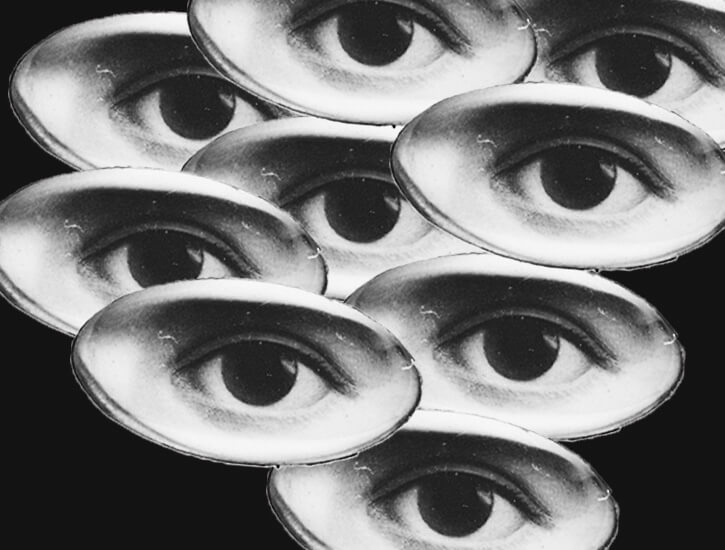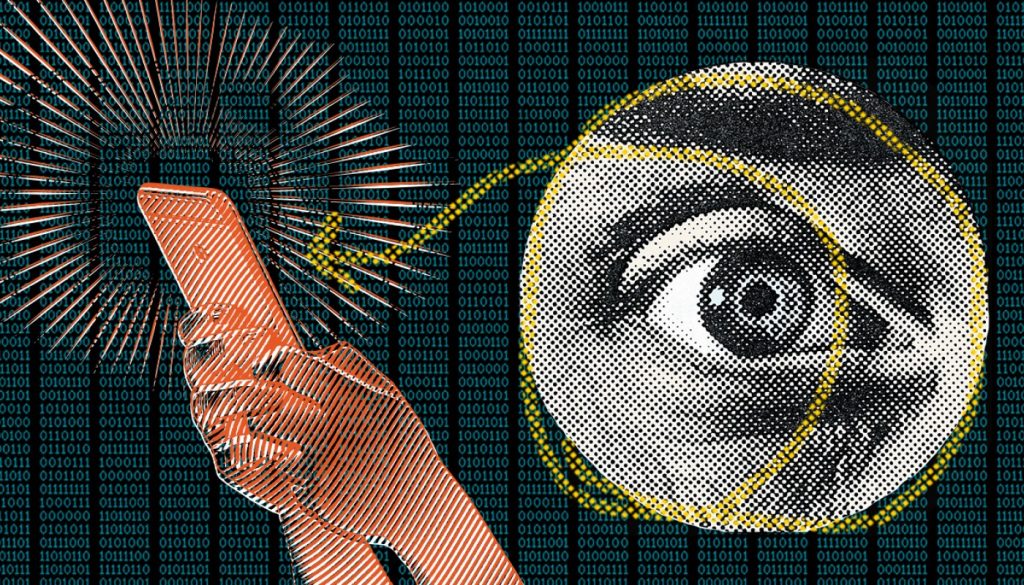Between the invention of the camera and the invention of the internet, privacy in the United States has undergone numerous mutations.
5 December 2022 (Berlin, Germany) – It all started on July 8th, 2000, when Matthias Fritsch was sitting on the back of a float during an alternative techno music festival known as the Fuck Parade in Berlin, Germany. As he casually filmed people walking and dancing behind the float, Fritsch saw one man stand out from the rest of the crowd. Stripped down to the waist, his ripped chest, braided beard and stern visage made him look like a Nordic berserker taking his dancing and parade etiquette very seriously. He was just a normal visitor to the Fuck Parade, which was a political demonstration. Years later Fritsch posted the video footage of the man online and the rest is internet history: the Techno Viking was born.
Destined to become one of the best know memes on the web, the Techno Viking inspired people to dress like him, dance like him, or simply point in the air like him. It was extremely fascinating to see it develop. After the video clip went viral, racking up tens of millions of views around the world, YouTube offered Fritsch advertising revenue. He also sold a few t-shirts, gave lectures on how memes spread on the internet and made arty videos about the phenomenon.
But apparently the Techno Viking decided he was not amused and sued Fritsch for invasion of privacy. Nothing happened for years until shortly before the case would exceed the statute of limitations, and Fritsch was required to appear before a German court. The Techno Viking received €13,ooo (about $13,700) in damages, all Fritisch made from YouTube ads and sales of Techno Viking merchandise, plus €10,000 in court costs, and had to cease publication of the image.
Fritsch now admits he should have asked after filming. But he thought he was allowed to film him because it was a political event in public. Besides, the camera wasn’t hidden, the Techno Viking walked into the shot and looked into the camera several times. He said he couldn’t say if the Techno Viking was actually hoping to turn back the clock 13 years or simply thinking his internet fame could lead to financial gain. But Fritsch said he still couldn’t understand why he was being sued for making someone so popular around the world.
The case set a data privacy standard in Germany which was copied by other European countries.
This past summer, New Yorker Lilly Simon realized that a stranger had taken a video of her while she was riding on the subway and posted it to TikTok, speculating that her neurofibromatosis type 1 tumors were monkeypox lesions. Simon posted a response calling the person out for filming her, and the original video was eventually removed – long after it had already gone viral – though it’s unclear if it was deleted by the poster or taken down by the app. There was no court case.
These incidents and their digital afterlives reveal the diminished extent, in an age where antisocial surveillance masquerades as social media, to which any of us might expect to have a right to “privacy” in public. In the United States, this right is a relatively new legal idea, despite the fact privacy as a concept predates its articulation. Originally conceived in the nineteenth century, it arose in response to one of the technological advances of the time: the camera. As more and more people started taking photographs – and later films – of people without their consent, the legal right to privacy was gradually established through both common law and legislation across the United States. But because the notion of privacy is an ambiguous one that evades easy definition, the first way that the right “to be let alone,” as it was originally described by Judge Thomas Cooley and adopted by Samuel Warren and Louis Brandeis, took root in the legal system was through the language of private property: your likeness was proprietary.
In this grim logic of commodification, we find the substrate of today’s mass mutual surveillance and data-harvesting.
Long before TikToking on the iPhone 14 Pro Max, there was the Kodak Camera, first unveiled in 1888, which made a previously expensive and cumbersome venture comparatively accessible to the masses. By 1896, over one hundred thousand had been sold, and those who couldn’t put them down were dubbed “Kodakers.” Advertisements likened photography to hunting, and men were often shown taking “shots” of women unbeknownst to them. The New York Times observed in 1889 that “if the young lady refuses he will perhaps strive to get her picture when she is not on guard just out of spite.” Photographs of random people were sold everywhere and even given away for free in packs of cigarettes. “Many people felt a profound sense of exposure and violation upon being photographed, or upon finding their photographs displayed and sold in photo shops, or used in advertisements, without their consent,” writes Robert E. Mensel in “Kodakers Lying in Wait.”
Among the United States government’s first confrontations with the question of privacy when it came to a person’s likeness—although the word privacy wasn’t used – came in March 1888, when Republican congressman John Robert Thomas introduced “A Bill to Protect Ladies” into the House of Representatives, which held that women who were related or married to American citizens were “entitled to protection from the vulgar and unauthorized use, for advertising purposes, of their likeness.” Inspired by the fact that images of First Lady Frances Cleveland were being used to advertise everything from cosmetics to ashtrays, the bill, in seeking to restrict the usage of women’s photographs, asserted that a woman’s likeness was essentially the property of the men she was related or married to, underlining exactly to whom the property rights of citizenship were accorded. Ultimately, the bill didn’t pass.
Privacy per-se wouldn’t be debated in the courts until the following century, when Abigail Roberson sued Franklin Mills and the Rochester Folding-Box Company for using her photograph to advertise flour. In Roberson v. Rochester Folding Box, Roberson’s lawyer argued that she possessed both a “right to privacy” and a “property right in her own features and beauty, which is absolute until voluntarily surrendered.” Although the case was overturned in appeals, it led New York State to create one of the first right to privacy statutes, concerning one’s likeness being used without consent for advertising or trade. Other states followed, and more and more breach of privacy cases relating to photographic images were brought to trial—though the legal strategies varied. Almost forty years after Roberson’s case, in March 1938, Pauline Myers won her case against Afro-American Publishing Co., who had published a photograph of her in a newspaper that was meant to be used for an artist’s model but was altered to accentuate her semi-nudity. Myers was one of the first Black people to bring forward a case regarding a breach of privacy and won based on New York’s privacy laws, but in Myers v. Afro-American Publishing Co., the action was regarded as libel since the photographs had been altered. Privacy rights weren’t mentioned at all. But while applying New York’s privacy statue, the photographs were instead described as her “exclusive property.”
The advent of film established another category of property rights when it came to privacy claims. In “The Face That Launched a Thousand Lawsuits”, Jessica Lake writes on two cases that were significant in revealing when a person’s likeness in film could be legally appropriated. In 1915, Stella Kunz was unknowingly filmed for an advertisement for the Allen and Bayne Store in Kansas City; after her lawsuit reached the Supreme Court of Kansas, the court ruled that she was entitled to damages. Gertrude Sweenek, on the other hand, gave oral consent to be filmed while exercising in New York in the 1930s, but the resulting footage was used in a newsreel with mocking captions. Unlike Kunz, Sweenek lost her lawsuit because, though she hadn’t consented to be humiliated, the so-called public interest to be informed superseded Sweenek’s right to privacy: as Judge Moscowitz noted when ruling for the defendant, “The amusing comments which accompanied the pictures did not detract from their news value.” As subsequent court decisions established, as long as nonfiction wasn’t mixed with a fictitious narrative, the so-called public interest overrode one’s right to privacy; anyone could be filmed without their consent as long as the “truth” was presented for the sake of the public. But all recordings are, to some extent, a fiction—a selective presentation of reality open to a world of possible interpretations.
In pushing back against the rights of those captured against their will on film, Picture Classics argued in the brief it submitted to the New York Supreme Court that the notion that people filmed without their consent had a right to privacy was ridiculous and, in doing so, made explicit the link between capitalist and colonial exploitation: “If the ruling below should be upheld, it would make impossible the exhibition of a travelogue showing the Dutch on the Island of Marken, the native quarter of Shanghai or the life of an African tribe. Every Hollander, Chinaman, and Negro whose features were distinguishable could insist that his rights were invaded and bring suit for damages for every public showing of the picture.”
In theory, the property right of privacy is one that every person has by virtue of having a likeness. And the legal system has proven relatively capable of defending this right against explicit commercialization, but invasions of an ostensibly “newsworthy” or “artistic” sort produce mixed results. With such a statement from Picture Classics in mind, it’s no wonder that fifty years later, Sharbat Gula had her photograph taken in an Afghan refugee camp in Pakistan by Steve McCurry without her consent – which went on to become “the most recognized photograph” in the history of the National Geographic. In a 2017 interview with the BBC, though, Gula said that “the photo created more problems than benefits. It made me famous but also led to my imprisonment.”
One hundred years ago, a person could enter a local movie theater and be shocked to find their face on the screen. With the omnipresence of smart phones, untold millions can now find that person in an instant. Anything and everything has the potential to be recorded and seen online. And once something goes viral, it often becomes the job of the person in the video to hunt down the original poster and assert themselves as more than just a piece of content-trash. In the meantime, the property right to privacy has also evolved into the right to publicity, establishing that the issue of privacy really turns on who profits from the exploitation of one’s likeness rather than the exploitation itself. And whereas it was once relatively clear when an image or a film was used for profit, now anything uploaded to the internet can be a source of revenue for both tech platforms and the poster.
In response to the Bill to Protect Ladies, the Albany Evening Journal argued that the use of a woman’s picture in an advertisement should be seen as a “compliment rather than an annoyance.” Even Judge Alton Parker, in overturning Abigail Roberson’s victory in Roberson v. Rochester Folding Box, stated that “she has been caused to suffer mental distress where others would have appreciated the compliment to their beauty implied in the selection of the picture for such purposes.” This mentality has scarcely changed. After his recording went viral, Matthias Fritsch used a similar argument to question why someone would be opposed to their likeness being represented in an ostensibly flattering manner. Wired writes that although Fritsch claimed that he could “totally understand” not wanting one’s image to be spread across the internet, becoming fodder for parodies, memes, and merchandise, he felt that as long as people thought highly of someone as a result, there wasn’t any problem. “Nobody thinks he’s the biggest loser in the world like other viral stars,” Fritsch added.
In 2002, Ghyslain Raza made a video of himself playing around while practicing Star Wars choreography. He hadn’t intended for the video to be public, but after another student discovered it, the video was distributed across the school and, in 2003, uploaded onto the internet. And while it became one of the earliest viral videos, Raza was bullied so much by his classmates that he dropped out and, struggling with severe depression, was forced to finish his exams at another school. In response to the lawsuit that Raza’s family eventually filed against his classmates, the press characterized Raza as greedy and out for “revenge.” Meanwhile, Raza himself said that “the point was to send a message that the media would understand . . . That people should behave more responsibly.” Three years after the video went viral, Raza’s family reached an undisclosed settlement in their lawsuit against three of Raza’s classmates that barely covered their legal fees, but by the end of that year, the video would be viewed almost 900 million times and become the source of endless parodies, demonstrating how woefully ill-equipped common law legal systems are at coping with matters of privacy in the age of the internet.
This discussion has, in its limited scope, focused mostly on the privacy rights of the living, but dead people have just as much of a right to privacy as anyone else. Unfortunately, precedent established in court cases like Lugosi v. Universal Pictures, Schuyler v. Curtis, and Maritote v. Desilu Productions, Inc. make clear that the property right of privacy rarely lasts beyond the grave. After Lugosi v. Universal Pictures, the state of California stepped in to create the California Celebrities Rights Act of 1986 to establish inheritable rights of likeness, but only for those who in life possessed immense commercial value. One must, the Golden State decreed, have successfully exploited oneself on the market to seek any sort of privacy protections in death.
But new legal precedents may yet be set. In 2019, Tamara Lanier sued Harvard University after photographs in its collection depicting Lanier’s ancestors—believed to be some of the oldest existing photographs of enslaved Black people in the United States—were used on a book cover and in Harvard materials for conferences without Lanier’s consent. The only way that Lanier can assert her ancestors’ right to privacy is by asserting that “Renty and Delia had a property interest in the photographs and that Lanier, as a descendant of Renty and Delia, currently holds such property interest.” After having spent their lives being exploited, Renty and Delia cannot even escape exploitation in death. But the only way the legal system may recognize their privacy is by reducing it to an inheritable property right. Unfortunately, this will inevitably chuck those without living relatives into the public domain, final wishes be damned. Middlesex Superior Court Judge Camille Sarrouf dismissed Lanier’s case in 2021, claiming that “the law, as it currently stands, does not confer a property interest to the subject of a photograph regardless of how objectionable the photograph’s origins may be.” But this year, the Massachusetts Supreme Court ruled that Lanier has the grounds to sue for emotional distress, and as of November, this case is ongoing.
The conceptualization of privacy as a property right has been easily exploited by tech platforms like TikTok, Instagram, and Twitter that blur the line between explicit and less overt—though perhaps more insidious—forms of revenue generation. By synthesizing advertising and data licensing with “public interest” media, they’ve allowed for the potential commercialization of every moment. Some photos or videos are shared for the sake of sharing information or spreading awareness of an injustice, but as any algo-massaged timeline indicates, most content is produced and circulated solely as entertainment, often at the expense of those depicted. These algorithms, not known for their nuance, are designed foremost to drive user engagement.
And as every moment becomes potentially profitable, the recording, uploading, and sharing of videos of strangers has become normalized to the point of unremarkability.
In some instances, reaching a wider audience can even be dangerous, as in instances where police have worked with facial recognition companies like Clearview AI, which mines social media for its database, and used footage and pictures from protests to arrest activists. Though the Supreme Court ruled in 1965’s Griswold v. Connecticut that there is an implied constitutional right to privacy, the current conservative supermajority seems poised to undermine it, and there remains no federal legislation governing the right to privacy when it comes to one’s likeness. As a result, people in different states have varying results defending their right to privacy.
Today, among American legal scholars, the most widely accepted definition of the right to privacy is divided into four distinct torts, one of which concerns the appropriation of one’s likeness. But even these definitions don’t establish what exactly privacy is, which continues to be hotly debated among philosophers and legal scholars. The concept isn’t ubiquitous worldwide and between the invention of the camera and the invention of the internet, privacy in the United States has undergone numerous mutations. Meg Leta Jones notes in her book “Ctrl + Z” that in the changing landscape of the internet, the right to privacy has also begun transforming into the right to be forgotten, which involves the removal of personal information from internet searches and has been applied in different jurisdictions worldwide—though, tellingly, not in the United States.
Social media has turned mass mutual surveillance into a pastime in the United States, but considering how our understanding of the right to privacy as property has evolved, it’s no wonder that these platforms are able to function and profit off of this mentality. Now, instead of scolding individuals for whipping out their phones, we must disentangle the idea of “privacy” from a logic that reduces everything to a commodity. The concept of privacy will always be mutable, but bound up as it has historically been in property relations only serves to limit our understanding of what it is and might be.






